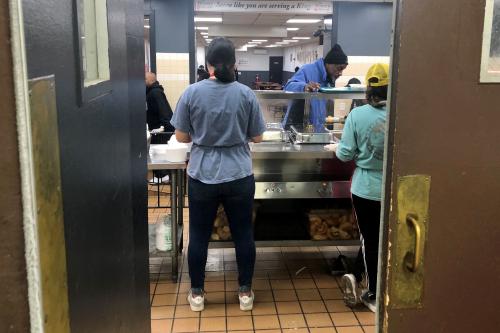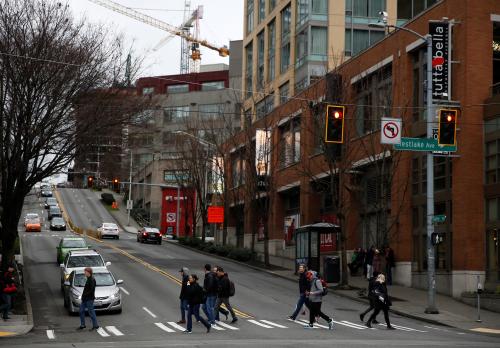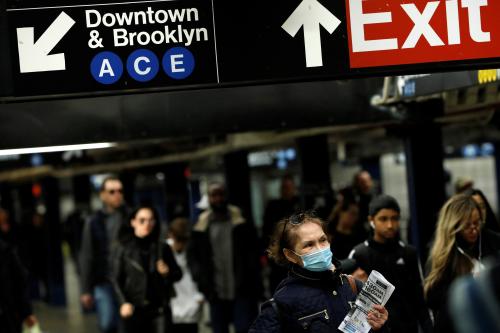The COVID-19 public health crisis is an extreme test of the necessity of many parts of our basic daily routine: commuting to the office, face-to-face meetings, and what it means to be a worker in the modern economy. With “social distancing” now an imperative in many places, employers’ transition to telework is poised to remake all of those assumptions, both for the current crisis and beyond.
The nation’s largest employer, the federal government, has issued new guidance on liberalizing telework, and this weekend the White House’s Office of Management and Budget urged agencies to “maximize telework flexibilities” for workers in the Washington, D.C. region. And earlier in the month, the nation’s second-largest private employer, Amazon (headquartered in the outbreak locus point of Washington state), asked its Seattle- and Bellevue-based employees to work from home for the remainder of March.
This surge in teleworking raises questions about whether the technologies that enable telework—video conferencing, remote desktops, etc.—can scale to handle coronavirus-related traffic, and what we can do to ensure all workers are able to take advantage of it. At the same time, the crisis also forces us to reconsider if there’s a loss of value at all when we don’t work face-to-face.
How common is telework already?
In 2018, nearly a quarter of the U.S. workforce (23.7%) worked some hours from home on an average day. And according to the Eno Center for Transportation, as of 2017 more Americans work from home than commute via mass transit.
Though the numbers are highest for those with advanced degrees, employees across the education spectrum also put in some hours from home. Further, telework isn’t limited to a specific geography—some of the densest metro areas boast high rates of telecommuting, while in rural areas, telework has slowed the “brain drain” some regions experience.
| Percent (%) | Survey Year | Description | |
| American Community Survey | 5.3 (National) | 2018 | Workers who usually worked from home in the last week |
| 5.2 (Urban) | |||
| 5.9 (Rural) | |||
| Bureau of Labor Statistics | 23.7 | 2018 | Workers who worked some hours at home |
| National Household Travel Survey | 11.9 | 2017 | Workers who usually work from home |
Telework helps make great places
In 1964, science fiction writer Arthur C. Clarke predicted that doctors on one continent would one day operate on a patient on another continent, but missed the mark a little when he concluded “the city is abolished.” While U.S. telework has grown rapidly, so too has the draw of place, especially for the knowledge economy. Information-sector jobs are clustering more densely in urban areas than ever. These jobs rely heavily on tacit knowledge and intense levels of cooperation between lots of people, which means employers value locations that foster communication, collaboration, interpersonal relationships, and trust. Given this, in recent years some employers have rejected telework. However, as the spread of coronavirus causes some of these employers to temporarily reverse course, we can begin to better understand the real potential of telework in the economy of the future.
The prominence of telework in the response to the coronavirus threat is a reminder that the technology can help employers manage other risks as well. For example, telework can enable firms to reduce the risk of losing productivity to regular or catastrophic traffic disruption. Offering telework as a benefit can help employers afford the cost of hiring high-skill labor, and keep these workers connected to the office and each other no matter where they’re based. Teleworking’s reach allows employers access to a larger group of potential workers and, in turn, allows workers access to more job options.
The prominence of telework in the response to the coronavirus threat is a reminder that the technology can help employers manage other risks as well.
Some have criticized telework as a marginal solution that benefits only white-collar workers. But even a simple, small solution can have a meaningful impact on multiple systemic problems. For example, even modest reductions in peak travel (i.e., commuting) can dramatically decrease traffic congestion, which benefits everyone. Furthermore, locating in an in-demand, high-cost urban area is more affordable for an employer when telework allows them to consume fewer square feet per worker, reducing land and energy consumption. Finally, the economies and societies of places enjoy increased stimulus from workers telecommuting from “third places” such as coffee shops and coworking spaces.
All people and places need access to telework
As more workers transition to remote work both in response to coronavirus and beyond it, there are structural changes that must be addressed to make it more accessible for everyone. Nearly 10% of working-age adults do not have a home broadband connection, according to American Community Survey data. Nearly a quarter of these broadband nonadopters say that services aren’t available or are too slow where they live. Broadband has long been considered a luxury good, but the transition to mandatory telework due to coronavirus makes it clear that an in-home connection is vital to the functioning of the 21st century economy.
The transition to mandatory telework due to coronavirus makes it clear that an in-home connection is vital to the functioning of the 21st century economy.
Recognizing the importance of broadband to social and economic functions, the Federal Communications Commission released the Keep Americans Connected Pledge to keep households connected through the fallout of the coronavirus. The pledge asks companies to open up public Wi-Fi networks, waive late fees, and not disconnect consumers over the next two months. A range of internet service providers joined the charge, offering free services to low-income customers or waiving overage fees. But this begs the question: Was internet connectivity not just as essential before? When the coronavirus passes, the FCC needs to take a serious look at what the pandemic has revealed about the importance of both telework and universal broadband access.
Telework does not eliminate the benefits of face-to-face work and social interaction, just as online shopping isn’t the end of brick-and-mortar retail. But at a time that requires social distancing, the same technologies that enable remote workers to stay productive can be leveraged to maintain social ties and connections. The coronavirus disruption is demonstrating that digital connectivity, including telework, is a valuable tool that makes places stronger and more resilient.
The Brookings Institution is committed to quality, independence, and impact.
We are supported by a diverse array of funders. In line with our values and policies, each Brookings publication represents the sole views of its author(s).









Commentary
COVID-19 makes the benefits of telework obvious
March 17, 2020